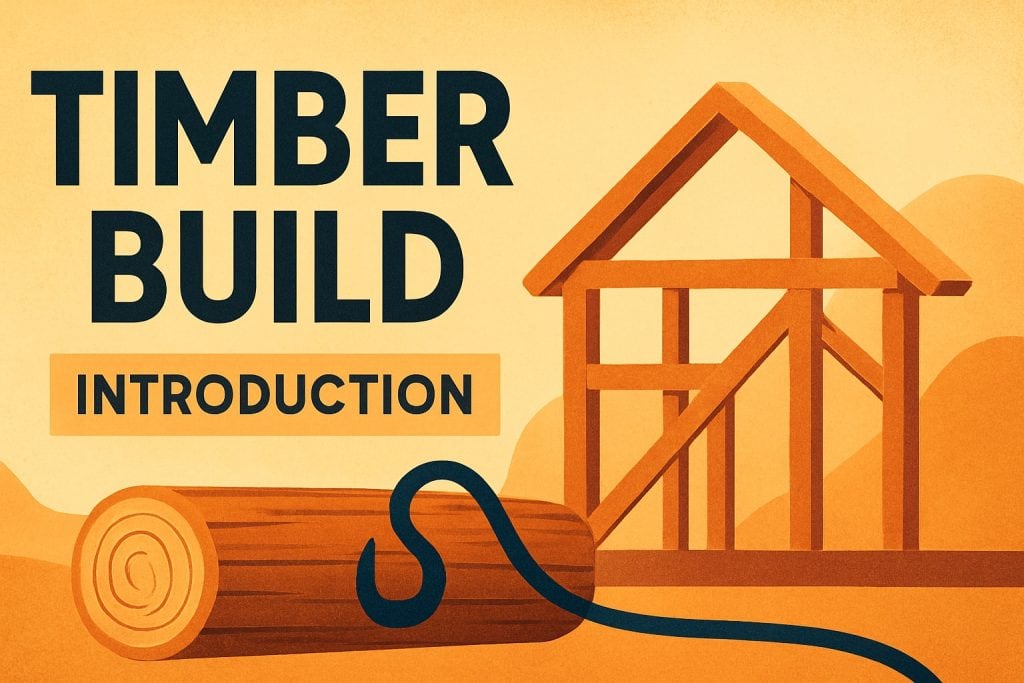Timber build projects continue to captivate homeowners and professionals alike, with a renewed focus on sustainable, stylish construction for 2025. This comprehensive guide bridges tradition and innovation, offering expert insights for every stage of your timber build journey. Whether you are planning a new home, extension, or commercial space, you will find practical advice, from initial planning and material selection to construction methods, sustainability, costs, and future trends. Discover why timber remains the material of choice for those seeking beautiful, high-performance spaces—explore the full guide and unlock the potential of your next project.
The Evolution of Timber Building: Tradition Meets Innovation
Timber has been central to the story of British construction for centuries. From medieval halls to rural cottages, the timber build tradition has shaped skylines and communities across the UK. The enduring appeal of timber lies in its warmth, versatility, and ability to blend seamlessly with both historic and contemporary architecture.
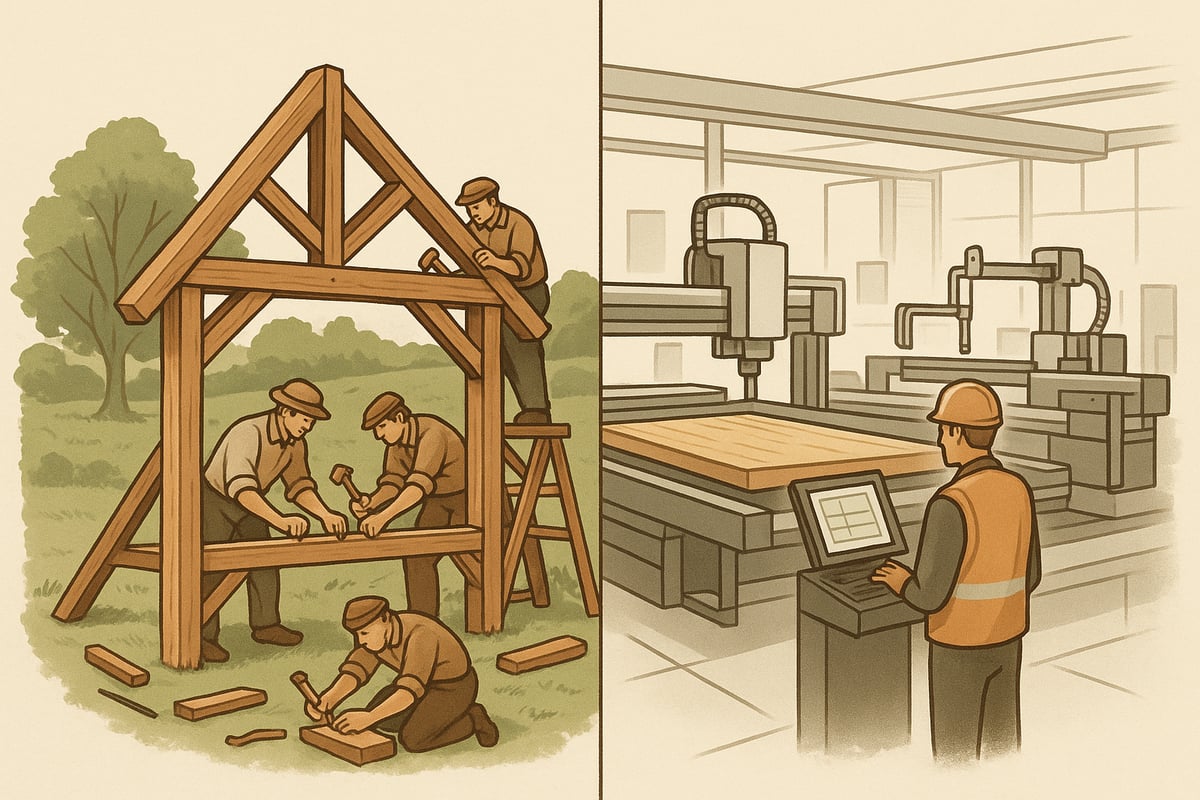
A Legacy of Craftsmanship
In earlier times, timber build projects relied on skilled artisans shaping oak beams with hand tools. Oak-framed barns and Tudor dwellings are testaments to this legacy, where every joint was crafted for strength and beauty. The timber build process was slow and labour-intensive, but it produced structures that have stood for generations.
From Tradition to Technology
The late 20th century marked a turning point for timber build practices. New techniques such as off-site prefabrication and CNC machining revolutionised how timber structures are designed and assembled. Instead of shaping every piece on site, much of the work now happens in controlled factory environments. Panels are cut with millimetre precision, improving quality and reducing waste.
Modern timber frame home construction leverages engineered wood products and advanced software to create complex designs with remarkable speed. This has opened the door for architects to experiment with bold forms, larger spans, and intricate detailing that would have been difficult with traditional methods.
Performance and Practicality
The evolution of timber build techniques has brought measurable benefits. Data shows that timber frame buildings can be erected up to 30% faster than conventional masonry systems. Prefabricated panels arrive on site ready for rapid assembly, minimising delays from unpredictable weather. Oak-framed houses, sleek timber extensions, and sustainable commercial buildings now showcase timber’s adaptability.
A comparison of methods:
| Aspect | Traditional Timber Build | Modern Timber Build |
|---|---|---|
| Main Material | Hand-cut oak | Engineered timber, panels |
| Assembly | On-site, by hand | Off-site, factory precision |
| Speed | Slow | Up to 30% faster |
| Flexibility | Bespoke, unique | Custom or modular options |
| Waste | Higher | Reduced, efficient |
Regulation and the Path Ahead
UK building regulations have played a vital role in raising standards for every timber build. Rigorous testing for fire safety, structural integrity, and energy performance ensures that modern timber build projects meet the highest benchmarks. This regulatory framework supports innovation, allowing timber to emerge as a leader in low-carbon, high-performance construction.
Looking ahead, timber build systems are uniquely placed to meet growing demands for sustainability and design flexibility. With new government strategies and advances in digital design, timber’s renaissance is set to continue, offering homeowners and professionals a blend of heritage and forward-thinking solutions for years to come.
Planning a Timber Build in 2025: Step-by-Step Guide
Starting your timber build journey in 2025 means balancing tradition with modern efficiency. From defining your ambitions to choosing systems and partners, careful planning ensures a smooth, successful result. This section guides you through each step, equipping you with the knowledge to turn your timber build vision into reality.
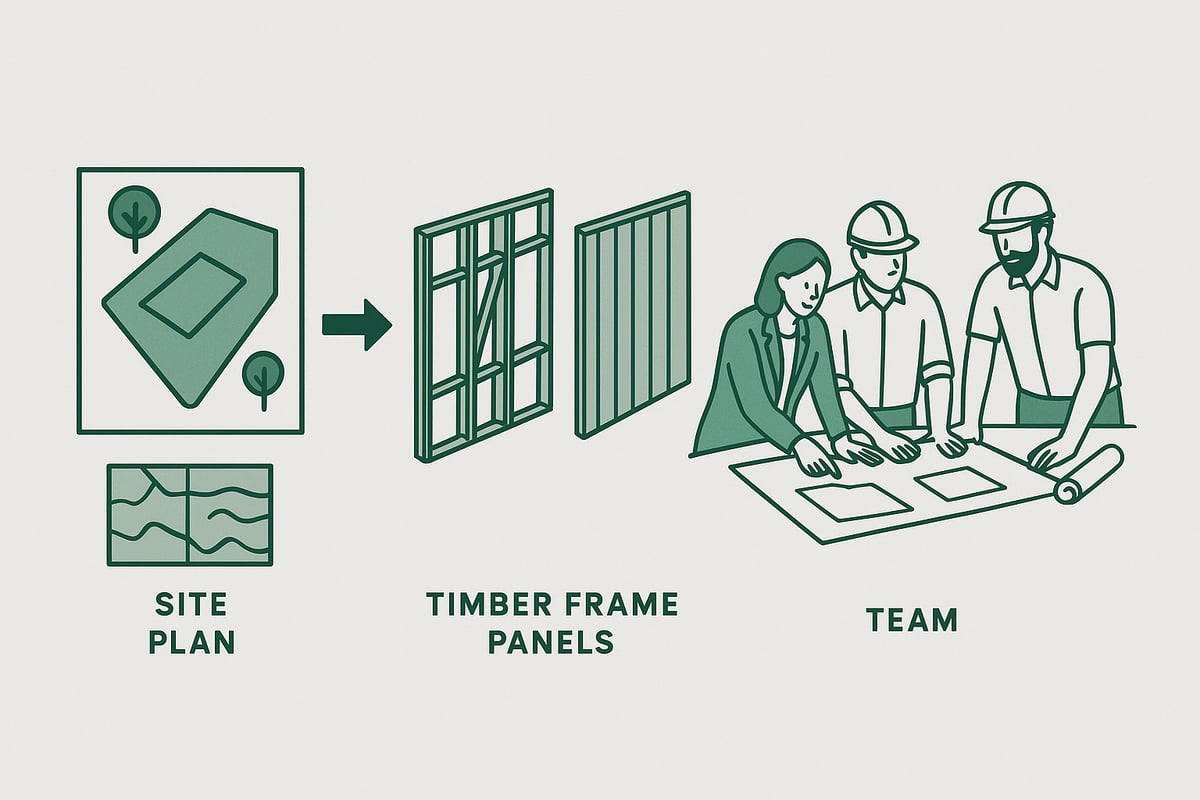
Understanding Your Project Scope and Requirements
Every successful timber build starts with clear project goals. Are you planning a new home, a spacious extension, a garage, or a commercial space? Define your end use and priorities early, as this shapes every future decision.
Navigating local planning permission and UK building regulations is crucial. Engage with your local authority to understand what’s required for your timber build. For extensions and home improvements, Timber Extension Planning Tips can help you avoid common pitfalls and prepare your application.
Assessing your site is the next step. Consider soil type, site access, and environmental factors. For example, tree roots or unstable soil might limit your foundation options and influence the overall design of your timber build.
Early engagement with architects and structural engineers is invaluable. Their expertise ensures your timber build complies with structural and sustainability standards from the start.
Budgeting is a key consideration. Typically, the superstructure accounts for 25 to 30 percent of your total timber build costs. Build a detailed budget and timeline, dividing your project into phases such as design, approvals, site preparation, construction, and fit-out.
Selecting the Right Timber Frame System
Choosing the most suitable timber frame system is a pivotal decision. The two main options are open panel and closed panel systems. Open panels provide flexibility, allowing on-site customisation, while closed panels come pre-insulated and pre-fitted with services for speedier assembly.
| System Type | Flexibility | Speed | Upfront Cost | Customisation | Example Use |
|---|---|---|---|---|---|
| Open Panel | High | Moderate | Lower | On-site | Bespoke homes |
| Closed Panel | Moderate | High | Higher | Factory-set | Modular builds |
Closed panels typically enable faster timber build completion, but they are heavier and may require cranes for installation. This can increase up-front costs but reduce time spent on site.
Consider whether a custom or standard kit suits your project. Custom kits are ideal for unique, architect-designed timber build projects, while standard kits can be efficient for modular schemes. For example, closed panels with pre-installed insulation and service cavities allow for rapid fit-out once erected.
Always check for warranty and certification. Ensure your chosen system meets UK regulations and carries recognised warranties, which are essential for peace of mind and future resale.
The Role of Expert Timber Frame Companies
Selecting a reputable timber frame company is vital for the success of your timber build. Experienced suppliers offer a full range of services, from initial design and engineering to manufacturing, installation, and aftercare.
Look for companies with a proven track record in both bespoke and kit timber build solutions. Many offer factory-controlled production, which delivers consistent quality and minimises the risk of on-site delays or defects.
Key services to expect include:
- Design collaboration with your architect or engineer
- Manufacture of panels or frames to precise specifications
- On-site assembly and installation
- Comprehensive aftercare and warranty support
A strong supplier will coordinate closely with other trades, ensuring your timber build progresses smoothly from start to finish. Factory assembly enhances quality control, while on-site expertise guarantees compliance with building regulations and project standards.
By partnering with an expert timber frame company, you gain access to the latest innovations, sustainable practices, and tailored solutions that add value to your property and lifestyle.
Timber Build Construction Process: Chronological Steps
Every successful timber build relies on a carefully managed step-by-step process. Understanding each phase helps ensure a smooth journey from the initial groundwork to the final handover. Whether you are a homeowner, self-builder, or professional, these chronological steps provide a clear roadmap for your timber build project.
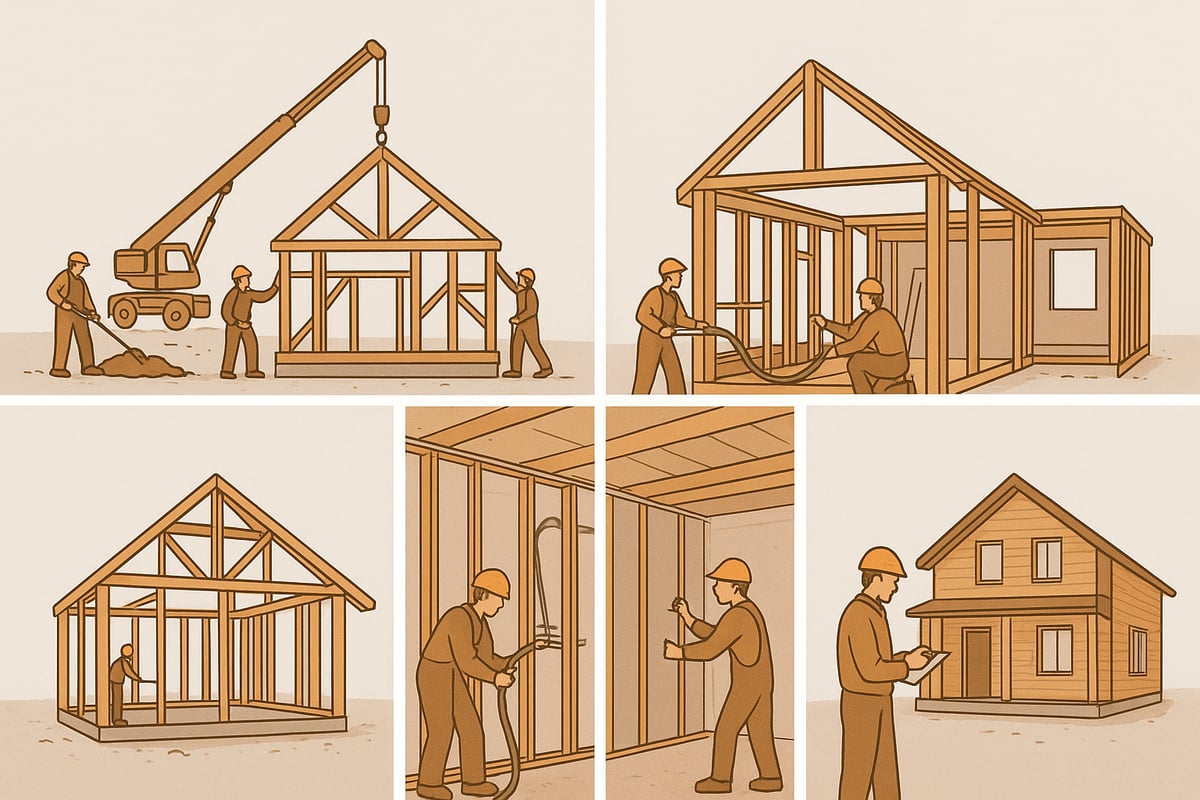
Step 1: Foundation Preparation
The first stage of any timber build is preparing the foundations. This involves clearing the site, removing debris, and levelling the ground. Groundworks typically take two to four weeks, depending on site access and weather conditions.
Choosing the right foundation type is crucial. Trench fill foundations work well on firm ground, while strip foundations are often selected for sites with challenging soils like clay or chalk. For example, cost-effective trench fill is a popular choice in areas with stable subsoil.
Building control inspections are required at this stage to ensure compliance with UK regulations. These checks confirm that the foundation meets structural standards and is ready to support the timber build. Early attention to detail here sets the stage for the rest of the project.
Typical Foundation Types and Durations
| Foundation Type | Suitable For | Duration |
|---|---|---|
| Trench Fill | Firm ground | 2-3 weeks |
| Strip Foundation | Challenging soil | 3-4 weeks |
Step 2: Frame Assembly and Erection
Once foundations are complete, the next step is assembling and erecting the timber frame. Most timber build projects use either open or closed panel systems, delivered directly to site. The frame assembly phase usually takes three to four weeks, depending on project scale and complexity.
Open panels are assembled on site, allowing for flexibility and adjustments during installation. Closed panels, which arrive with insulation and services pre-installed, speed up the process but often require cranes due to their weight. Both systems use oriented strand board (OSB) or plywood for structural stability.
Weatherproofing is a key milestone in this phase. Achieving a watertight shell quickly protects the timber build from the elements and allows internal works to commence. Careful coordination ensures panels are installed in sequence, minimising delays and keeping the project on track.
Step 3: First Fix Installations
With the frame in place, the first fix stage begins. This involves installing essential utilities such as electrical wiring, plumbing, and HVAC systems. Skilled trades work alongside the main contractor to ensure all services are correctly positioned within the timber build structure.
For closed panel systems, service cavities are often pre-installed, making this phase more efficient. Open panel systems require trades to route services on site, which can take slightly longer. Effective scheduling and clear communication between teams help avoid clashes and keep the timber build moving forward.
Regular inspections at this stage check that all installations meet current regulations. Addressing any issues early prevents costly delays later in the project.
Step 4: Second Fix and Internal Finishing
The second fix phase transforms the structure into a finished space. Plasterboarding, joinery, and finish carpentry are carried out, followed by the installation of kitchens, bathrooms, and fixtures. Attention to detail is critical, as this step defines the look and feel of the timber build.
Typically, second fix and internal finishing take a few weeks, depending on the size and specification of the project. Many timber build projects benefit from the clean, dry environment provided by the watertight frame, allowing internal works to progress without interruption.
Throughout this phase, close coordination between trades ensures a high-quality result. Snagging lists are created to catch any minor defects, ensuring the finished timber build meets expectations.
Step 5: Testing, Inspections, and Handover
The final stage focuses on quality assurance and compliance. Air tightness and soundproofing tests are carried out to confirm the timber build meets performance standards. Building control officers conduct final inspections, reviewing work against UK regulations.
Once all tests are passed, warranties and documentation are handed over to the client. Any outstanding snags are addressed, and a thorough handover process ensures the new owners understand how to care for their timber build.
This step marks the successful completion of the project, delivering a durable, efficient, and beautiful timber build ready for occupation.
Timber Build Systems: Comparing Methods and Materials
Selecting the right timber build system is essential for achieving your vision, meeting performance targets, and staying on budget. Advances in design and manufacturing mean there is a wide range of approaches to suit every project, from traditional homes to cutting-edge commercial spaces.
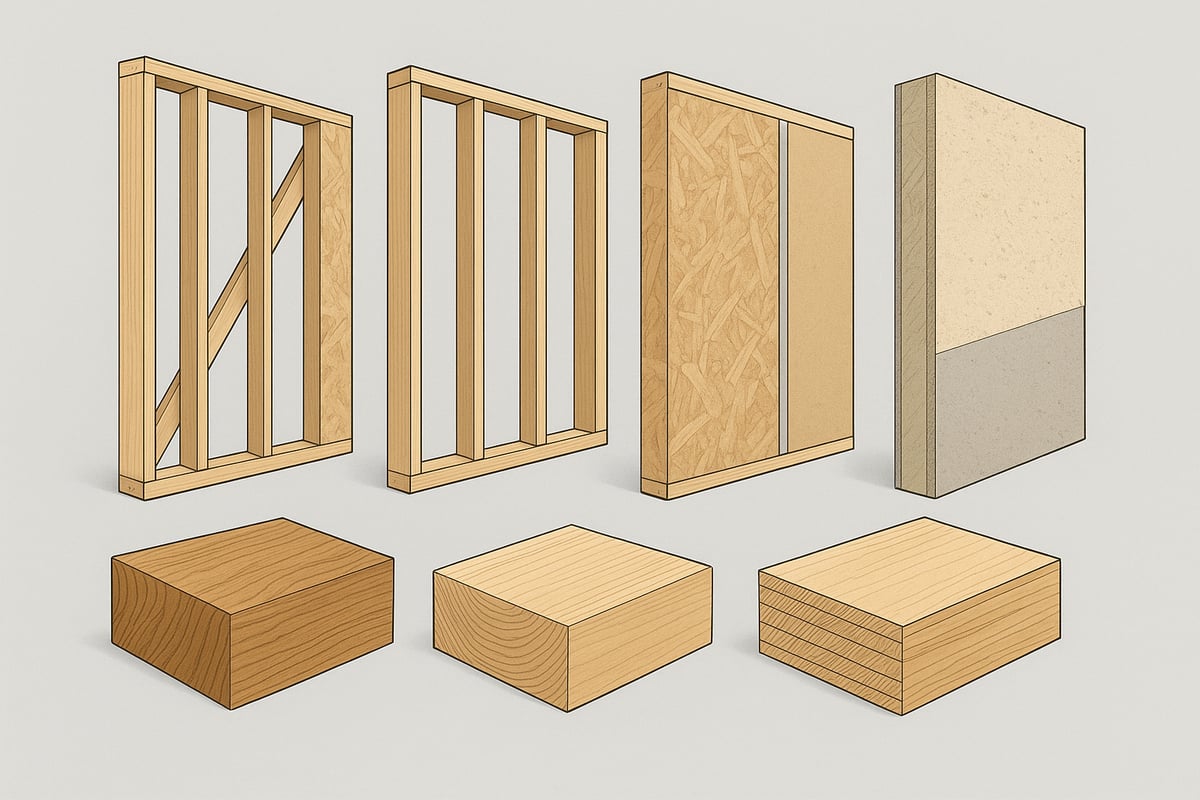
Stick Built vs. Pre-Manufactured Timber Frames
Understanding the difference between stick built and pre-manufactured timber frames is the foundation of any successful timber build. Stick built systems involve assembling each structural element on site, while pre-manufactured frames are precision-engineered off site and delivered as panels.
| System Type | Assembly Location | Speed | Quality Control |
|---|---|---|---|
| Stick Built | On site | Slower | Variable |
| Pre-Manufactured | Off site | Faster | High, factory-based |
Stick built timber build methods offer flexibility for small or bespoke projects. However, they are more susceptible to weather delays and inconsistent workmanship. Pre-manufactured systems, on the other hand, deliver panels that are rigorously tested for fire resistance and structural integrity before arriving on site.
A significant advantage of pre-manufactured timber build frames is the improved speed and precision, which can reduce construction time by up to 30% compared to traditional methods. Warranty coverage is often more comprehensive due to the controlled manufacturing environment. For a deeper dive into the systems and styles available, see this log and timber frame homes guide.
Open Panel, Closed Panel, and Structural Insulated Panels (SIPs)
When planning a timber build, choosing between open panel, closed panel, or SIPs is crucial. Open panel systems consist of structural frames with sheathing and allow for on-site customisation of insulation and services. Closed panels come pre-insulated and may include vapour barriers, windows, and service voids, streamlining the installation process.
Structural Insulated Panels (SIPs) are engineered panels with integrated insulation sandwiched between structural boards, offering outstanding rigidity and thermal performance. SIPs are often favoured for projects demanding high energy efficiency and rapid construction.
Closed panel systems are especially popular for turnkey timber build solutions, as they arrive ready for immediate assembly, reducing weather risks and site labour. SIPs suit both homes and commercial buildings where airtightness and insulation are paramount. Open panels are best when flexibility and on-site adjustments are priorities.
Material Choices: Oak, Softwood, Engineered Timber
The choice of timber defines the character and performance of a timber build. Oak remains the premium option for bespoke projects due to its strength, longevity, and timeless appearance. It is especially valued in visible structural elements and traditional designs.
Softwood, such as spruce or pine, is widely used for cost-effective and high-volume timber build projects. It offers a balance of strength and affordability, making it suitable for most residential frames.
Engineered timber, like laminated veneer lumber (LVL) or glue-laminated beams, delivers unmatched precision and consistency. These products are ideal for complex shapes and large spans, ensuring superior performance and minimal waste. Always look for FSC or PEFC certification to guarantee responsible sourcing and support sustainable forestry in your timber build.
Sustainability and Energy Efficiency in Timber Builds
Sustainability is at the heart of every modern timber build. As environmental standards climb and the demand for low-carbon solutions intensifies, timber builds are leading the way in eco-friendly construction. Homeowners, self-builders, and professionals alike are seeking not just beautiful spaces but also responsible choices that support a greener future.
Timber as a Sustainable Material
A timber build stands apart as a renewable and low-carbon option. When sourced responsibly, timber stores carbon throughout its lifespan, lowering the overall environmental impact of a project. UK standards require timber to be certified by schemes such as FSC and PEFC, ensuring forests are managed sustainably.
The environmental benefits are substantial. Timber construction typically uses less energy in production than steel or concrete alternatives. According to Sustainability in Timber Construction, timber offers a significantly lower embodied carbon footprint, making it a preferred choice for those aiming to meet strict climate goals.
For anyone planning a timber build, responsible sourcing is more than a box-ticking exercise. It is a commitment to protecting woodland habitats and supporting a circular economy. Choosing certified suppliers is crucial for both compliance and peace of mind.
Energy Efficiency in Timber Build Projects
Energy efficiency is a defining feature of the modern timber build. Timber frames are well suited to high-performance insulation and airtight construction, making it easier to achieve excellent U-values and reduce heat loss. Many closed panel systems arrive on site with insulation already integrated, streamlining the path to energy-efficient living.
Timber build methods naturally support the principles of passive house design. The precision engineering of panels and joints helps minimise thermal bridging, while the use of advanced membranes and seals ensures long-term airtightness. These features translate into lower energy bills, enhanced comfort, and a reduced carbon footprint for the life of the building.
It is not just about insulation. Efficient timber build projects also focus on optimising glazing, orientation, and ventilation. By combining these strategies, a timber build can deliver homes that are both comfortable and cost-effective to run.
Lifecycle and Responsible Sourcing
The lifecycle of a timber build is shaped by durability, ease of maintenance, and end-of-life recyclability. Modern treatments and design techniques ensure timber structures stand the test of time, often lasting for generations with minimal intervention. Routine checks and simple maintenance, such as repainting or resealing, protect the building fabric and preserve its value.
Responsible sourcing remains central throughout the project. Timber build projects that use FSC or PEFC-certified timber not only comply with UK regulations but also contribute to the sustainability of global forestry. This approach allows self-builders and professionals to demonstrate their environmental credentials, both to clients and planning bodies.
When the time comes for refurbishment or demolition, timber build materials can often be recycled or repurposed, closing the sustainability loop. This reduces landfill waste and supports a circular construction economy.
Innovations and Future Outlook
Innovation is rapidly advancing the sustainability of every timber build. Offcuts and waste materials are increasingly being reused within manufacturing processes or repurposed for other products, further reducing the environmental impact. Recycled timber is appearing in both structural and decorative roles, offering unique character while conserving resources.
Eco-friendly finishes and treatments are another frontier. Water-based paints, natural oils, and low-VOC sealants help maintain indoor air quality and safeguard occupant health. As the sector evolves, digital design and precision manufacturing are enabling even greater efficiency and less waste in every timber build.
Looking ahead, the drive for net-zero carbon and circular construction will continue to shape how timber build projects are delivered. By embracing these innovations, homeowners and professionals can ensure their timber build remains future-ready and truly sustainable.
Cost Factors and Value Considerations for Timber Builds
Understanding the cost factors for a timber build is crucial for any homeowner, self-builder, or professional planning a project in 2025. With timber's popularity on the rise, getting a clear picture of where your money goes ensures better decision-making and helps maximise long-term value.
Cost Breakdown and Key Influences
The cost of a timber build is shaped by several core components. These typically include the superstructure (timber frame), foundations, roofing, glazing, and internal finishes. The superstructure alone usually represents 25–30% of the total build cost. For many self-build projects, overall costs can start from under £80,000, depending on size and specification.
Key influences on budget include design complexity, roof shape, the amount and type of glazing, and site-specific factors such as access and ground conditions. For example, challenging sites with unstable soil may require more robust and costly foundation solutions. The choice between open or closed panel systems also impacts costs, with closed panels typically carrying a higher upfront price but saving time on site.
Material choice is another factor. Engineered timber, which is seeing strong growth in the UK market, can offer better precision and reduced waste, but may be priced differently compared to traditional softwood frames. These variables all play a role in shaping the final price of a timber build.
Comparing Timber Build Costs to Traditional Methods
When weighing up a timber build versus traditional brick and block construction, several advantages emerge. Timber frame builds are often significantly quicker to erect. This speed can lead to notable savings in site labour and associated costs, as well as reduced exposure to weather-related delays.
Direct construction costs for timber builds can be competitive, particularly when factoring in the reduced time on site. Closed panel systems, for instance, may have a higher initial outlay, but the rapid installation can offset these costs. According to the Timber in Construction Roadmap 2025, government policies are increasingly supporting the use of timber, which may help stabilise costs and encourage wider adoption.
Other factors, such as local availability of timber and current market trends, can also influence cost comparisons. As engineered wood products gain traction, the market continues to evolve, offering both cost and performance benefits for timber build projects.
Value, Savings, and Financing Considerations
Long-term value is a key attraction of a timber build. Superior energy efficiency, thanks to high-performance insulation and tight construction tolerances, can result in considerable savings on heating and cooling bills over the lifetime of the home. Timber builds also tend to generate less construction waste, supporting sustainability goals and reducing disposal costs.
Ongoing maintenance for modern timber structures is typically low, with durable finishes and engineered timbers designed for longevity. These attributes can enhance property value and appeal to future buyers seeking eco-friendly features.
Financing a timber build often involves staged payments, with deposits required for design and manufacturing, and further payments aligning with key milestones such as frame delivery and completion. Insurance is essential to protect your investment throughout the build process. By carefully planning costs and understanding value drivers, you can ensure a successful and cost-effective timber build project.
Future Trends and Innovations in Timber Building for 2025
As the construction landscape moves into 2025, the timber build sector is experiencing a surge of innovation. New technologies, changing regulations, and growing sustainability ambitions are shaping how timber is used in both residential and commercial projects. Staying ahead of these trends is crucial for anyone planning a timber build in the coming year.
Digital Design and Precision Engineering
Digital transformation is revolutionising the timber build process. Building Information Modelling (BIM) and advanced 3D modelling tools now allow architects and engineers to visualise every component before a single piece of timber is cut.
These technologies improve precision, reduce on-site errors, and enable seamless collaboration between design and manufacturing teams. Precision engineering, including CNC machining, ensures that timber build components fit perfectly, speeding up assembly and minimising waste.
Prefabrication, Modular Construction, and Smart Homes
Prefabrication is becoming a defining feature of the modern timber build. Off-site manufacturing of panels and modules reduces build times and enhances quality control. Modular construction methods further streamline the process, making it easier to deliver projects on schedule and within budget.
Smart home integration is another growing trend. Timber build systems are now designed to accommodate sensors, automation, and energy management solutions, making homes more efficient and future-proof.
Regulation, Sustainability, and Market Growth
Regulatory changes are driving higher standards for energy efficiency and safety in every timber build. The move towards net-zero carbon targets means more projects are specifying responsibly sourced timber and advanced insulation.
Sustainability is not just a trend, but a necessity. The UK market is seeing a shift towards engineered wood and certified timber, reflecting both regulatory requirements and client demand. Recent reports highlight that UK timber imports decline slightly with engineered wood showing strong growth, underlining the sector's evolution and the increasing preference for innovative timber build materials.
Multi-storey Timber and Hybrid Solutions
One of the most exciting developments in timber build is the rise of multi-storey structures. Engineered timber products, such as cross-laminated timber (CLT), enable taller buildings with greater structural integrity.
Hybrid solutions, combining timber with steel or concrete, are also gaining popularity for commercial and public sector projects. These approaches offer the best of both worlds: the sustainability of timber and the strength of traditional materials.
Looking ahead, timber build methods are set to become even more adaptable, efficient, and sustainable. With evolving client expectations and ongoing innovation, timber will remain at the forefront of modern construction.
As you’ve seen throughout this guide, timber building in 2025 is all about blending time-honoured craftsmanship with the latest design innovations for results that are both beautiful and sustainable. If you’re inspired to take the next step—whether you’re dreaming of a bespoke oak-framed home, a striking extension, or a practical garage—working with experts ensures your vision becomes reality, tailored to your needs and fully compliant with UK regulations. Ready to bring your project to life with a team who values quality and detail at every stage?
BUILD NOW
